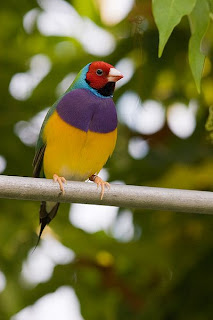Both sexes are brightly colored with black, green, yellow, and red markings. The females tend to be less brightly colored. One major difference between the sexes is that the male's chest is purple, while the female's is a lighter mauve.
Black headed female Gouldian Finch
Gouldian Finches are about 130–140 mm long. Gouldian Finches' heads may be red, black, or yellow. Formerly considered three different kinds of finches, it is now known that these are colour variants that exist in the wild.Selective breeding has also developed mutations (blue, yellow and silver instead of a green back) in both body and breast color.
Juveniles also have distinctive colors. Their heads, sides and necks are grey, and their backs, wings and tail feathers are olive green. Their undersides are pale brown. Beaks are blackish with a reddish tip. Their legs and feet are light brown. Newly-hatched Gouldian Finches are pink and naked until about 12 days old when the beginnings of feathers start to appear. Very young birds also have blue, phosphorescent beads on the sides of their beaks to help their parents see them in the dark.
Data refer : http://en.wikipedia.org/wiki/Gouldian_Finch




